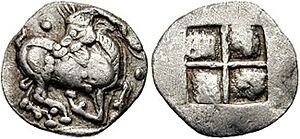Amyntas I of Macedon facts for kids
Quick facts for kids Amyntas I |
|
|---|---|

Silver trihemiobol struck c. 510-480 BC, possibly a civic issue from Aegae. Obv.: goat kneeling right, head reverted; rev.: incuse square with four sections.
|
|
| King of Macedonia | |
| Reign | c. 512–498/497 BC |
| Predecessor | Alcetas |
| Successor | Alexander I |
| Born | ? |
| Died | 498/497 BC |
| Spouse | unknown |
| Issue | Alexander I Gygaea |
| Dynasty | Argead |
| Father | Alcetas |
| Mother | unknown |
| Religion | Ancient Greek religion |
Amyntas I (Ancient Greek: Ἀμύντας) was a king of the ancient Greek kingdom of Macedonia. He ruled from around 512 BC until his death in 498/497 BC. Amyntas is important because he is the first Macedonian king about whom we have reliable historical information. During his time as king, Macedonia became a state that had to follow the rules of the powerful Persian Empire around 510 BC.
Contents
Who Was Amyntas I?
Amyntas I was part of the Argead dynasty, a famous royal family. His father was King Alcetas. Amyntas was the sixth king of Macedonia in this family line.
He had two children with his wife, whose name is not known:
- Alexander I
- Gygaea
Amyntas's Time as King
Macedonia and the Persian Empire
Around 513 BC, the Persian Empire was growing very strong. Their leader, Darius I, led his armies across the Bosporus strait. He successfully fought against the Scythians and secured new lands.
After this, Darius sent his cousin, Megabazus, to conquer more areas in Thrace. Megabazus marched west around 512 or 511 BC. He took control of several local tribes. One group, the Paeonians, were even moved to Asia. Amyntas I might have used this chance to expand his own kingdom. He may have taken over some of the land the Paeonians used to control.
Around 510 BC, Megabazus sent seven messengers to Amyntas. They likely met at the palace in Aegae. The Persians asked for "earth and water." This was a symbolic way of asking for submission. It meant that Amyntas should accept Persian rule.
Amyntas agreed to their demands and invited the messengers to a big dinner. According to ancient stories, the Persians asked for women to join them after dinner. Amyntas agreed, even though it was not typical Macedonian custom. The women were present, and the Persian messengers started to act disrespectfully. Amyntas stayed quiet because he was afraid of the powerful Persians.
Amyntas's son, Alexander, was very angry about this. He asked his father to leave and let him handle the situation. Amyntas was careful, but he eventually left. Alexander then sent the women away, saying they were going to wash. Instead, he brought in young men dressed as women. These men were secretly armed with daggers. They returned to the party and killed all seven Persian messengers.
To cover up what happened, Alexander made a clever plan. He arranged for his sister Gygaea to marry a Persian general named Bubares. He also gave Bubares a large gift. This helped to hide the fact that the Persian messengers had been killed.
Some historians today are not sure if this story is completely true. It might have been made up to show how clever Alexander was. Or, it could be a story that was simply repeated by the historian Herodotus. It is also unlikely that Amyntas would have left such an important meeting to his young son. However, Gygaea's marriage to Bubares is believed to be a real event. Amyntas probably arranged it himself, or Alexander did so after his father's death.
Some historians believe that Macedonia was not a vassal state during Amyntas's reign. They think that Mardonius, another Persian general, actually took control of Macedonia later, in 492 BC. However, other historians believe that Macedonia remained loyal to Persia until the Persians were defeated at the Battle of Plataea in 479 BC.
Amyntas and Athens
Amyntas I was the first Macedonian ruler to have diplomatic relations with other states. This means he communicated and made agreements with them. He formed an alliance with Hippias, a ruler from Athens.
When Hippias was forced to leave Athens, Amyntas offered him land called Anthemus. This land was near the Thermaic Gulf. Amyntas hoped that by helping Hippias, he could take advantage of the disagreements among the Greeks. Hippias refused the offer. He also turned down an offer of land in Iolcus. This was probably because Amyntas did not fully control Anthemus at that time. He was likely suggesting a plan for them to take control of the land together.
Family Tree
Historians sometimes disagree on the exact family connections of the Argead dynasty. The chart below shows one common way historians understand the early Argead family.
 (1) Amyntas I (r. c. 513 – 497 BC)
(1) Amyntas I (r. c. 513 – 497 BC)
 (2) Alexander I (r. 497 – 454 BC)
(2) Alexander I (r. 497 – 454 BC)
 (3) Perdiccas II (r. 454 – 413/2 BC)
(3) Perdiccas II (r. 454 – 413/2 BC)
*![]() (5) Orestes (r. 400/399 – 398/7 BC) *
(5) Orestes (r. 400/399 – 398/7 BC) *![]() Argaeus II (r. 388/7 – 387/6 BC) *Pausanias *unnamed daughter
Argaeus II (r. 388/7 – 387/6 BC) *Pausanias *unnamed daughter![]() Derdas of Elimea *unnamed daughter
Derdas of Elimea *unnamed daughter![]() Amyntas II
Amyntas II
*![]() (8) Pausanias (r. 394/3 – 393/2 BC)
(8) Pausanias (r. 394/3 – 393/2 BC)
*![]() (11) Ptolemy of Aloros (r. 368 – 365 BC)
(11) Ptolemy of Aloros (r. 368 – 365 BC)
-
-
- Amyntas
- Arrhidaeus
- Amyntas
-
*![]() (9) Amyntas III (r. 393/2 – 370 BC)
(9) Amyntas III (r. 393/2 – 370 BC)
- From whom Philip II and Alexander III is descended.
See also
- Ancient Macedonians
- List of ancient Macedonians

